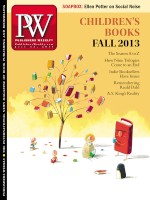For the Fall 2013 children's announcements issue, we spoke with nine writers whose trilogies are drawing to a close this fall. They shared what it takes to keep dozens of characters and thousands of pages straight--and how it feels when it's all over.
At what point did you know this was a trilogy?
When I reached about page 350 of UnWholly [book #2], and realized it wasn’t even halfway done. When I tried to restructure it as two books, I realized I had a perfect place for splitting the story. I thought UnSouled would come in at around 400 pages, but it took 650 pages, and even then I felt like I was rushing the conclusion, so I asked my editor and publisher if I could divide it again. So a sequel became a trilogy, and the trilogy became a tetralogy—although we’re not calling it that. We concluded that a dystopian tetralogy is a “dystology,” so we coined the term!
Did you have any special method for keeping details straight?
I have a color-coded computer spreadsheet that divides things down to chapter fragments. Each character’s point-of-view is a different color. The text of the manuscript is color-coded the same way. The last thing I do before submitting the manuscript is turn all those colors back to black.
Any favorite scene or character left on the cutting room floor?
I wrote a reunion scene between the three main characters from Unwind (Connor, Risa and Lev) in UnSouled — but then I realized that Lev still had a lot more to do on his own, so now the scene only exists in an alternate universe! The Unwind books are also being developed as movies now by Constantin Films, and I wrote the early drafts of the first film. Now there’s a new writer, and all those scenes are on the cutting room floor now—new stuff that I had come up with just for the film—but, ironically, the production company wants the first film to be closer to the book, and the new writer can deliver that better than me, because I keep wanting to reinvent.
Did anything develop plot-wise that completely surprised you?
Always. Before I start, I trick myself into thinking I know what’s going to happen in the story, but the characters have ideas of their own, and I always go with the character’s choices. Most of the time I discover plot twists and directions that are better than what I originally had planned.
What reward did you give yourself for finishing?
Typing the words “The end,” and hitting the “send” button is reward enough. I took the rest of the day off, and in the morning I got to work on my next project.
Click here to read the other interviews.
Editor's note: This article has been edited to include additional material from the interview.



 Volume 260
Issue 28
07/15/2013
Volume 260
Issue 28
07/15/2013





